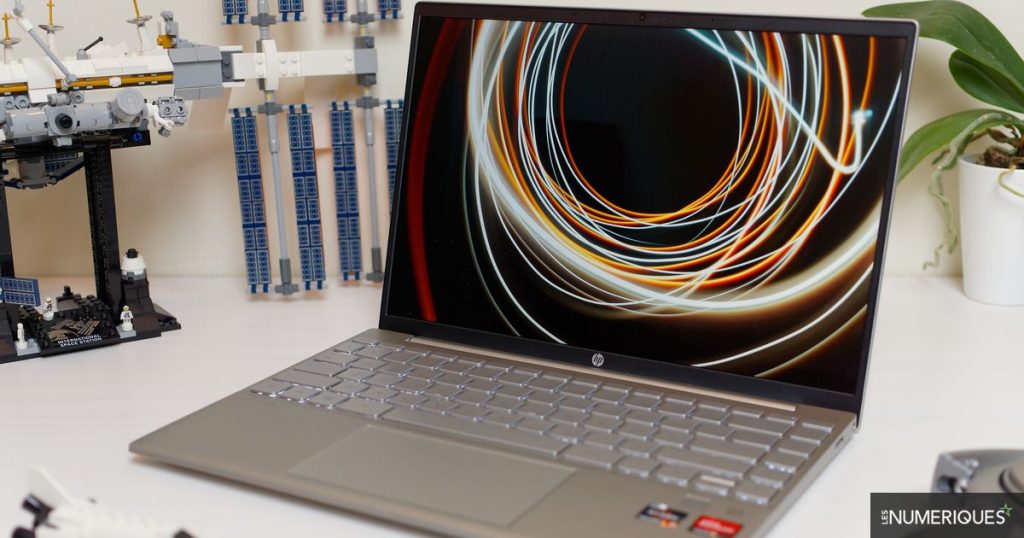
HP Pavilion Aero 13 Ultrabook review (be0053nf): A solid featherweight
The Aero 13 body is made entirely of plastic in gray. The chrome-plated HP logo adorns the back of the display in the center of the cover. Despite weighing 951 grams, the Aero 13 isn’t particularly thin. The use of plastic makes it possible to contain the weight, but at a lower cost than aluminum or magnesium alloy. The Aero 13 looks a bit hollow, but without the chassis squishing excessively under pressure.
Opening the cover reveals a matte screen with a relatively thin border, even at the bottom.
The keyboard sports keys in the same color as the rest of the chassis. The disadvantage of the gray keys, the activation of the backlight makes the keys unreadable, not to mention that the intensity of the light is not the most important.
Typing looks a little hollow and the large keys (space, offset, back) suffer from little play. HP made a strange choice regarding the positioning of the “down” icon key: the latter is located in the “Right Ctrl”, just to the left of the “left arrow” key, which leads to many typing errors. Under the arrow keys, a Windows Hello compatible fingerprint reader is integrated into the palm rest. We would have preferred to integrate it directly into the start button to the left of the “Delete” key.
The touchpad offers a gentle slithering, Windows gestures are perfectly taken into account, and on the other hand, drag and drop with one finger is very difficult.
The Pavilion Aero 13’s connectivity consists of an HDMI 2.0 port, two USB ports (5 Gb / s), a USB-C port (10 Gb / s) that supports charging, and a DisplayPort.
Wifi 6 as well as Bluetooth 5.2 is also included to ensure wireless connectivity. The 720p webcam complements the Pavilion Aero 13’s equipment. With good lighting, the quality is just right even if the image lacks detail. In the dark it is a little more complicated, the picture is very noisy and suffers from chromatic aberrations.
To cool its processor, the Pavilion Aero 13 uses a single fan that turns out to be very discreet, even under heavy pressure from Ryzen 5. Thus we notice 35.1 dB while encoding the video. On the heat release side, the Aero 13 is also very compact (37.6°C at the hinge).
To access the components, it is necessary to remove the two anti-slip strips to unscrew the five Phillips screws holding the casing. You should then gently loosen the chassis around the chassis, but also in the center of the chassis.
Inside, the wifi card, SSD, and battery can be accessed and replaced. On the other hand, the memory is soldered. Aero 13 is available with 8GB or 16GB of RAM, we advise you to choose the 16GB version for more durability.
The HP Pavilion Aero 13 is equipped with an AMD Ryzen 5 5600U processor, 16 GB of RAM and a 512 GB SSD. excessive It is clocked at 2.3 GHz and can sometimes go as high as 4.2 GHz. In practice, during encoding, its average frequency is 2.72 GHz, with a maximum frequency of 4.24 GHz.
Performance index (the higher the better). © The Digital
This is the first time we’ve had a Ryzen 5 5600U in our hands and it works very well. With a performance index of 95, it completely exceeds Intel’s low-power range and faces a Core i7-11390H that has almost twice as much heat as the Ryzen 5 5600U.
A word about the built-in SSD: up to 1.8 GB / s in reading and 1.6 GB / s in reading. We didn’t notice any noticeable slowdown while transferring fast videos, which allows us to run our tests.
The Pavilion Aero 13 does not have the dimensions of an average body of 13.3 inches: 29.7 x 20.9 cm, the size of an A4 sheet. We can’t even talk about versatility because it’s 1.69 cm thick. The Pavilion Aero stands out for its weight, weighing in at exactly 952 grams on our scale. However, its 65W charger weighs approximately 300g with a “mickey” cable. HP would have offered a USB-C charger, and this would have made it possible to have an additional USB-C port and save weight.
The lightness of the body is mainly explained by the small 43.3Wh battery that HP used in its Aero 13. So it is not surprising that you get a battery life of only 5 hours 50 minutes when playing video (Netflix under Chrome at 200 cd / m² ). The only way to increase this autonomy is to reduce the brightness. As a troubleshooting tool, the USB-C port supports charging, so it is possible to connect an external battery.

“Incurable web evangelist. Hipster-friendly gamer. Award-winning entrepreneur. Falls down a lot.”
